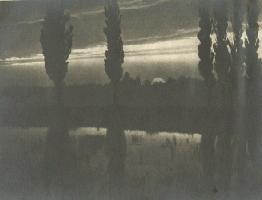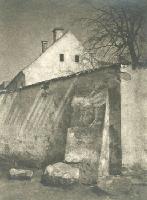
Bulhak, Trees at Sunset
Jan Bulhak was born October 6, 1876 in Ostaszyn near Nowogródek, which at the time was part of Russian Lithuania. Nowogródek had been a part of the Kingdom of Poland until Poland's third partition in 1795, when Nowogródek was incorporated into the Russian Empire. The area was reincorporated into Poland again from 1918-1939. It is now a part of Belarus.
Bulhak learned to photograph about 1905 after his wife Anna was given a camera for a present. He attended classes with Hugo Erfurth in Dresden and worked as his assistant from about 1910-1911.
His first photo was published in December 1908 in "Zycie Ilustrowane" (the weekly supplement to the "Kurier Litewski"). In early November 1910, Bulhak started to publish his writings on photography in the "Fotograf Warszawski" monthly. It was this publication that made Fedynand Ruszczyc, a well-known landscape painter and a professor in the department of fine arts at the Stephan Batory University at Wilno, aware of Bulhak by about November 10th of that year. If it were not for Ruszczyc, Bulhak might have never moved to Wilno.

Bulhak, Building in Nowogrodzkie
Working with Ruszczyc, Bulhak photographed and published the architecture and monuments of Wilno and other areas in Poland and Lithuania beginning in 1919, although he had taken images of Lithuania as early as 1906. He often worked in series of images around a specific theme, an idea he later revisited. In 1915 he published six albums "Lithuania in Photographs by Jan Bulhak" with originally 270 photos). He photographed Warsaw and other areas, including Plock, Cracow, Lublin and Lwow from September 1920.
He opened his own studio in Wilno, Poland in 1912. With Ruszczyc's help and encouragement, Bulhak also lectured and became first the assistant to and then the manager of the Institute of Photography in the department of fine arts at Stephan Batory University at Wilno (1919-1939). In 1927 he helped found the Wilno Photo-Club, which became one of the most important photography groups in Poland during the pre-war years. It was followed by the birth of the Polish Photo-Club in 1929, also co-founded by Bulhak with Marian Dederko. This group included most of the important photographers in Poland. By 1931, the group had 26 members and Bulhak was chairman. The declaration of war in 1939 changed all of this, and put Bulhak's career on hold.
Bulhak also made friends with Constant Puyo, Roberta Sizeranne and Leonard Misonne, who helped him come to Paris in the 1920s. He is generally considered to be one of the most influential photographers in Poland in the early 20th century.
Bulhak exhibited in 174 fine art photography salons in Poland and abroad. He won gold medals at Wilno in 1913 and 1924, Poznan in 1923, and Varsovie in1936. He also took silver at Madrid in 1927 and Saragosse in 1927. A list of some of his other salons is included later.
Bulhak also did considerable commercial work. He reportedly photographed Canadian Pacific offices in different Polish cities.
By WWII, Bulhak had made between 40,000 to 100,000 negatives, which he presented as a collection to the Polish state in 1939, but unfortunately most of these works were destroyed during the war. His main collection "Polska w obrazach fotograficznych Jana Bulhaka" consisted of over 11,000 negatives. His own archive of prints was also destroyed during WWII when a fire destroyed his apartment and this massive archive during the battle for Poland. Consequently, Bulhak's vintage work is very rare and is not often seen outside of Poland. A few of his negatives have apparently survived. Jolanta B. Kucharska reports that she saw original Bulhak negatives (glass 13 x 18 cm) in the Arts Institute in 1994, as well as a few paper negatives in the Museum of Photography in Siauliai (Lithuania), and glass diapositives in the Academy of Fine Art in Vilnius.
His son Janusz studied music at the Vilnius Conservatory. Bulhak taught his son photography in 1935-38. The son joined him in his studio about 1940 (although one other source says about 1944). All photos made in 1945-1949 are signed "Jan Bulhak and Son". Bulhak moved to Warsaw after WWII.
Bulhak also wrote numerous books and articles on photography aesthetics and techniques. Propably the first book publication of Bulhak's photographs was in "Wilna, Eine Vergessene Kunststatte", published by the German 10th Army in Wilno in 1917. In 1919, Bulhak published the book "Moja Ziemia" (My Land), a poem (160 pages of it) in a numbered edition. He published one of his books, Aesthetics of the Light (Estetyka Swiatla), in 1936, which is illustrated with his own images.
However, his most important contribution was arguably his conception of “native photography.” Its principals, set down by Bulhak in 1938, focused on the idea that Polish creativity always possessed national characteristics. According to him, photographic creation can express national sentiment and character through choice and interpretation of various themes, and he attacked the new photography trends coming out of Germany and the Bauhaus for their abstract qualities and technical focus.
In 1951 his book "Fotgrafia ojczysta" was published just after he died.
Bulhak worked at a time of transition and battle between the aesthetics of traditional romantic soft-focus pictorialism and those of the newer, more realistic modernism. His own fine art photographs illustrate this transition and conflict. A few later images retain the hazy compositions not unlike his earlier Bromoil prints, but some exhibit the vantage points and sharpness of the new aesthetics. He often used paper negatives to produce some of his moody images, which, while they were a throwback to his pictorialist roots, were also considered a part of his encouragement of a nationalist romanticism. Critics are divided though as whether to give him a position as simple pictorialist illustrator or as precursor of a Polish avant-garde movement.
William Ewing said in his article for the catalogue La Photographie Polonaise that Bulhak's best work taken of forms and architectural details is at once both direct and stripped to elemental values. "This work exceeds simple documentation to form a body of photographs that are expressive, even surrealist; although they do not depart from a documentary viewpoint, they do achieve that which makes all great art: the transformation (or transmutation)."
Bulhak's photography work is in many Polish institutions, including the Warsaw Institute of the Arts, Museum of Fine Arts in Lodz, the Warsaw National Library, and the Krakow Museum of Photo History. His images are also in the collections of the Canadian Centre for Architecture and the Iris & B. Gerald Cantor Center for Visual Arts at Stamford, CA.
There are many variations on the spellings of his name and he is said to be Lithuanian and Russian in some texts. Several of his images and a short biography are published in an important new book on Russian pictorialism, Pictorial Photography in Russian: 1890s-1920s, Moscow, 2002; other photographs and biographical information are included in La Photographie Polonaise, published by the Centre Georges Pompidou. His work was included in the Photographica Polska exhibit at the ICP in New York in 1979, and one of his images appeared on the cover of this catalogue.
He died February 4, 1950 in Gizycko, Poland.
He is cited in Contemporary Photographers, Macmillan Biographical Encyclopedia of Photographic Artists, Auer & Auer's Photographers Encyclopedia International, Witkin and London's The Photograph Collector's Guide, and the George Eastman House database.
Partial List of Exhibitions:
1909 or 1910 International Exhibition in Brussel (bronze medal)
1911 Wystawa Sztuk Pieknych in Minsk
1911 Wystawa Fotografii in Ciechocinek (famous Polish spa)
1912 Warszawa, Polish Landscape (honored diploma)
1925 International Exhibition of the London Salon of Photography Royal Society
1925 Primo Salon Italiano D'Arte Fotografica Internazionale Gruppo Piemontese per la Foto
1926 7th Annual Salon of Pictorial Photography Albright Art Gallery
1927 14th Annual Pittsburgh Salon of Photographic Art, Carnegie Institute
1928 15th Annual Pittsburgh Salon of Photographic Art, Carnegie Institute
1928 Toronto Salon of Photography: Canadian National Exhibition, Toronto Camera Club
1928 8th Annual Salon of Fine Art and Pictorial Photography, Provincial Exhibition of Brit
1929 10th Annual Salon of Pictorial Photography, Albright Art Gallery
1929 First Annual International Photographic Salon - Chicago Camera - Art Institute of Chicago
1929 Pacific International Salon of Photographic Art, Art Museum (Portland)
1929 Internationella Fotografi Utstallningen
1929 Salon Internacional de Fotografia, Agrupacion Fotografica de Catalonia
1929 First Rochester International Salon of Photography Art Gallery
1930 6th Annual and First International Invitation Salon for 1930, Japan Photographic Society
1930 11th Annual Salon of Pictorial Photography, Albright Art Gallery
1930 Internationell Fotografi Utstaallning i Skaanska Gruvan Skansen, Nordiska Museet
1930 75th Annual Exhibition of The Royal Photographic Society
1932 15th Annual International Salon of Photography, Los Angeles Museum
1981 La Photographie Polonaise, Centre Georges Pompidou
1992 Les Chefs - D'Oeuvre De La Photographie Polonaise 1912-1948, Muzeum Sztuki
2002 Pictorial Photography in Russian: 1890s-1920s, Moscow
Credit for this information must go to many sources, including, but not limited to, Janusz Fila, the Georges Pompidou Museum of Contemporary Art, Jolanta B. Kucharska and Serge Plantureux.
Exhibited and Sold By
Contemporary Works / Vintage Works, Ltd.
258 Inverness Circle
Chalfont, Pennsylvania 18914 USA
Contact Alex Novak and Marthe Smith
Email info@vintageworks.net
Phone +1-215-518-6962
Call for an Appointment



Share This